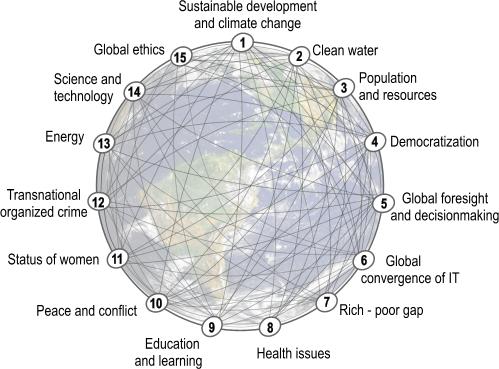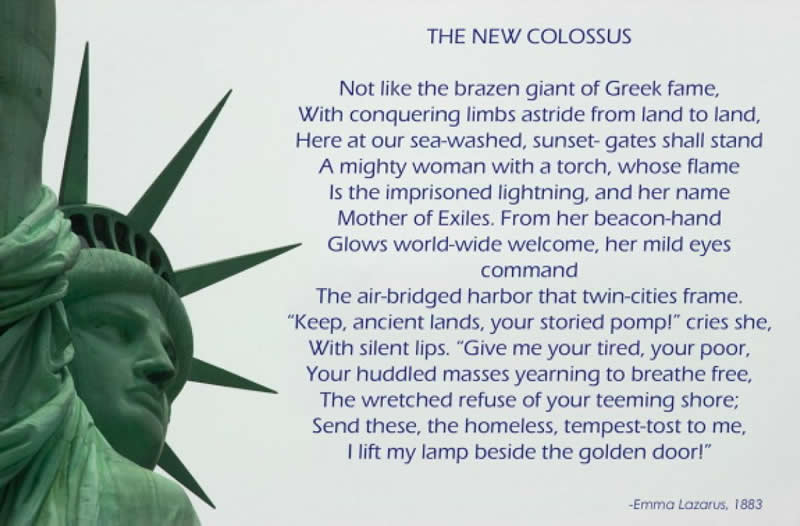Lesson 20: Population, Urbanization, and the Environment
Attention

This graphic depicts the interconnection between various issues that make up our human ecosystem.
Each of these contributes to global wellness and safety.
Learning Outcomes
Upon completion of this lesson's material, students will be able to:
- Based on the Concentric Zone Theory, describe your personal experience with different cultures related to the Zone in which you have lived.
- Discuss the concept of Water Security and its relation to national and world security.
Teaching
It isn't the Planet that is in trouble...
As the human population on our planet continues to rise we are faced with very large and looming questions about our survival as a species. While we might characterize these as "Saving the Planet" we are truly simply trying to save ourselves!
Can our planet sustain this level of growth? If so, can we learn to work together to ensure that vital resources like water, food, shelter, and safety are available to everyone on the planet?
Demography
Demography is the study of population trends. Fertility rates, mortality rates, male/female, rich/poor...these are just of the few statistics that are used to describe groups of people, nations, or even the entire planet.
- Malthusian Theory
- This theory stated that the actual capacity of the planet to sustain populations was finite. Malthusian posited that events such as "war, famine, and disease" actually served to keep the population of the planet in balance with the capacity of the planet.
- Zero Population Growth
- Concerned with the collapse of our natural resources, this perspective proposes that we should strive to sustain our current populations by only "growing" as fast as we are "shrinking".
- Cornucopian Theory
- Scoffs at the idea of humans wiping themselves out. This approach supports that innovation, science, and technology will solve the issues of the day. This is apparent in both the energy and agricultural world.
- Demographic Transition Theory
- This four stage description of how demographics change over the course of the history of a society also has clear examples in the world.
- Stage 1 - Birth, death, and infant mortality rates are high, life expectancy is low. (US in the 1800s)
- Stage 2 - Birth rates are high, infant mortality is low, life expectancy is increasing. (Afghanistan today)
- Stage 3 - Through industrialization, birth rates high, life expectancy is high (Mexico today)
- Stage 4 - Birth and death rates are low, high life expectancy, population stabilizes (Sweden today)
- This four stage description of how demographics change over the course of the history of a society also has clear examples in the world.
Immigration
As I write this, there is likely no hotter topics (except maybe health care) on the national agenda than immigration.
The US has long been a "light" that has attracted immigrants to a better way of life. One of the most stunning examples of this is the poem that accompanies the Statue of Liberty. I find it very moving and telling of how much of our country is about the "melting pot" or "patchwork quilt" of multi-culturalism.

One perspective of the importance of immigration is the "ecological" one.
In the world of Biology we have come to understand that an ecosystem is more stable if there is a wide variety of species in that ecosystem. Applied to societies, this has come to represent that a society that is a mix of various cultures is more stable.
Urbanization
Along with technology, urbanization is a major culture shifting agent. As we learned from the Shoemaker story back in the beginning of the class, Sociology has its roots in the events of large groups of people starting to live in close quarters during the Industrial Revolution.
Interesting ideas to consider when thinking about urbanization are:
- Urban centers
- Suburbs
- Exurbs
- Metropolis
- Megalopolis
Concentric Zone Model
- Zone A, in the heart of the city, is the center of the business and cultural district.
- Zone B, the concentric circle surrounding the city center, is composed of formerly wealthy homes split into cheap apartments for new immigrant populations; this zone also houses small manufacturers, pawn shops, and other marginal businesses.
- Zone C consists of the homes of the working class and established ethnic enclaves.
- Zone D holds wealthy homes, white-collar workers, and shopping centers.
- Zone E contains the estates of the upper class (in the exurbs) and the suburbs.”
Where do you live now? Have you ever lived in a different type of Zone? Were the people there different?
The following video covers the Concentric Zone Model (and two other models) for land use and development.
Climate Change
There really is no debate. Issues related to climate change include:
- Sustainable populations
- Pollution
- Food supply
- Water supply
- Air quality
Water security is a major emerging global issue. While scarcity of water is rarely experienced here in Maine, it is a global issue.
Click HERE to look at the UN University's Water Security & the Global Water Agenda
Click HERE to look at the Intelligence Community Assessment on Global Water Security and it's potential impact on US National Security.
Here is a quote from that report:
"Our Bottom Line: During the next 10 years, many countries important to the United States will experience water problems—shortages, poor water quality, or floods—that will risk instability and state failure, increase regional tensions, and distract them from working with the United States on important US policy objectives. Between now and 2040, fresh water availability will not keep up with demand absent more effective management of water resources. Water problems will hinder the ability of key countries to produce food and generate energy, posing a risk to global food markets and hobbling economic growth. As a result of demographic and economic development pressures, North Africa, the Middle East, and South Asia will face major challenges coping with water problems. "
Assessment

Lesson 20 Discussion
Look up information related to Water Security. Discuss the potential outcomes of "Water Wars" or the privatization of water supplies.
Lesson 20 Quiz
- Considering the concentric zone model, what type of zone were you raised in? Is this the same or different as that of earlier generations in your family? What type of zone do you reside in now? Do you find that people from one zone stereotype those from another? If so, how?